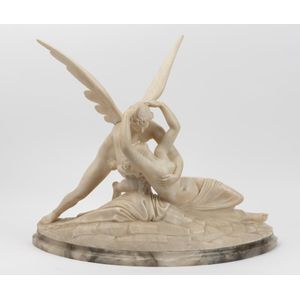Revived Love: Canova's Psyche and Cupid Statue
A marble statue, 'Psyche Revived by cupid's Kiss', after Antonio Canova, 19th century, the carrara marble sculpture featuring the languishing Psyche and her rescuer upon a bow shaped alabaster base, after the 1787 original, 32 cm high, 60 cm long
You must be a subscriber, and be logged in to view price and dealer details.
Subscribe Now to view actual auction price for this item
When you subscribe, you have the option of setting the currency in which to display prices to $Au, $US, $NZ or Stg.
This item has been sold, and the description, image and price are for reference purposes only.
- Cupid Motif - The Cupid motif, which features the Roman god of love and desire, Cupid, was a popular decorative element in classical ornamentation. Cupid was often depicted as a winged, naked baby with a bow and arrow, and was often used to symbolize love and desire.
In classical art and architecture, Cupid motifs were often used as decorative elements on furniture, such as on the legs of chairs and tables, as well as on architectural elements such as friezes and pediments. They were also used as decorative elements in frescoes, mosaics, and other forms of art.
During the Renaissance, Cupid motifs were often incorporated into the decoration of palaces, churches and other grand buildings, as they were seen as symbols of love and fertility. Cupid motifs were also commonly used in the decorative arts of the Baroque period, often appearing in the form of putti, which are small winged cherub figures.
In addition to their decorative use, Cupid motifs were also believed to hold symbolic meaning, as they were thought to evoke feelings of love, desire, and fertility. - Alabaster - Alabaster is soft natural stone used for statuary, with a similar appearance to marble, but easier to work with. As it is softer than marble, an item made from alabaster can be scratched with a metal object, and an alabaster item does not polish to a high surface gloss like marble.
Alabaster objects can be semi-translucent. Alabaster occurs in a pure white form and also with veining from dirt. Colours vary from white through yellow and pink to brown. The veining is usually green or black but can be multicoloured.
Being semi-translucent, alabaster is often used for the bowls of figural lamps, with the figure itself being either alabaster or marble. - Carrara Marble - Carrara marble is a type of white or blue-grey marble quarried in the Carrara region of Tuscany, Italy. It is prized for its beauty, durability and the ease with which it can be worked. The marble has been used for thousands of years for sculptures and architectural details, and was particularly popular during the Renaissance period. Some of the most famous sculptures in the world, such as Michelangelo's David, were carved from Carrara marble. It is also widely used in the construction of buildings, floors, and countertops, both indoors and outdoors. This marble is known for its unique veining which gives it a distinctive look, and it's a popular choice for interior design, especially bathrooms and kitchens.
This item has been included into following indexes:
